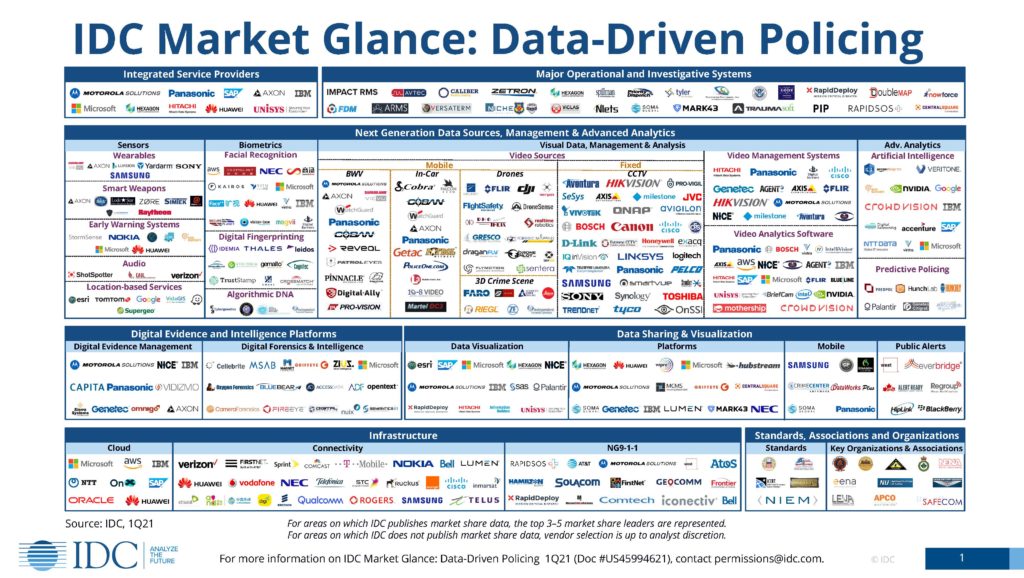Police agencies today are trying to transform into being more data-driven agencies. This is in part because agencies recognize the value of granular, real-time insights, particularly when they’re married with long-term trending information. Agencies are also interested in data-driven policing because of the sheer volume of data being created, and the comparative lack of information being distilled into useable insights. Globally, agencies are struggling with the volume of digital data, assets and evidence needing to be managed in a coordinated, efficient manner. Currently most agencies have multiple, disparate systems that patch together insights in a slow and laborious manner.
What is ‘data-driven policing’?
Data-driven policing is defined as the ethical use of next-generation technology to manage heterogenous data sets and sources, to proactively bolster decision-making, enhance situational awareness, and improve workflow for police personnel. It is an increasingly important solution set to address data manageability. While this blog isn’t specifically focused on the rising ethics and transparency issues in policing, folks interested in the topic can read more about it in our IDC perspective, Top Ten Public Safety Trends.
Why is Data-Driven Policing Important?
Police agencies increasingly struggle to rein in the volume, variety, and velocity of digital assets coming into the agency. Plus, some of these are literally ‘net-new’ data sources like large data sets generated by communications service providers, cloud service providers, laptops, and smartphones, as well as skyrocketing volumes of video and photographic evidence. Many of these digital assets, and the solutions to make sense of them, did not exist even five years ago. It is, indeed, a complex, complicated undertaking. Here we see a plethora of video sources, sensors, and biometrics, all of which need to be managed within a digital evidence platform, increasingly leveraging complex analytical tools like AI. Video has proven to be an incredible boon to agencies, but the growing number and types of video sources being developed have been somewhat confounding. We have seen dramatic increases in the volume of video sources, spanning privately owned, city-owned and police CCTV cameras, body-worn cameras, in-car cameras and dashcams, interrogation videos, drone video, and, last but not least, smart phone video recordings.
IDC’s data-driven policing MarketGlance, Data-Driven Policing, 1Q21, provides a more in-depth look at the various vendors working in the data-driven policing space. In this document we parse the various subcomponents of the market and list key vendors in each area. Figure 1 below provides the top-level view of this space:

In order to morph from their current state – comparatively reactive, manual and siloed processes – into data-driven policing agencies will require a strategic vision, and considerable changes to workflow to deliver. Where should agencies be parking their technology spend then? If we consider data-driven policing as one of the programs contributing to future-focused, next-generation public safety, what use cases are necessary investments to underpin this transformation? (Please see our Smart Cities and Communities Spending Guide, IDC’s Worldwide Smart Cities Spending Guide Taxonomy, 2020: Release Version 1, 2020 for detailed forecasting of critical investments opportunities). IDC believes that the key use cases are:
- Digital Evidence Management: Digital evidence management solutions integrate all sources of digital data, assets and evidence, quickly and seamlessly in a format that is usable for all police functions.
- Digital Forensics: Digital forensics is a division of forensic science encompassing the recovery, investigation, validation and analysis of evidence found in digital devices like laptops or smart phones and on digital databases, networks and platforms including social media platforms and cloud hosted data repositories. Digital forensics solutions help investigators collect, analyze, and preserve digital evidence.
- Body-worn Video Cameras: Body-worn video cameras are devices that record the audio and video of interactions with residents, suspects, and victims and are currently the most common officer wearable.
- Officer Wearables: IoT or sensor-enabled wearables are contributing to improved situational awareness, officer safety, and incident decision making. Officer wearables include smart holsters, glasses and sensored apparel.
- Fixed Video Surveillance: Fixed visual surveillance cameras, installed by police or public services, are increasingly valuable investigation tools as they record events in real time and provide law enforcement with digital investigative tools and evidence.
- Next-generation 9-1-1: Next-gen Public Safety Answering Point (PSAP) technologies dramatically improve situational awareness, community safety and resilience, and the more efficient use of resources. A combination of 3rd Platform technologies allows first responders to collect better information, enhance situational awareness, manage digital evidence from new sources, and deploy resources more effectively and quickly.
- Real-time Crime Centers: RTOCs seek to automate the investigation and response processes, as well as lessening the amount of time for information transfer to occur.
With the continuous growth of digital assets, data-driven policing is more important than ever. The use cases underpinning this transformation augment policing capabilities, while reining in digital chaos and complexity. Agencies are better equipped to transform data into information, information to knowledge, knowledge to insight, and, finally, insight to action. To learn how to successfully adopt data driven policing and the technologies needed to utilize these initiatives, join us for the upcoming webinar, “Moving to Digital. Re-establishing Trust. Optimizing Efficiencies” live on March 31st at 11 AM/ET.




